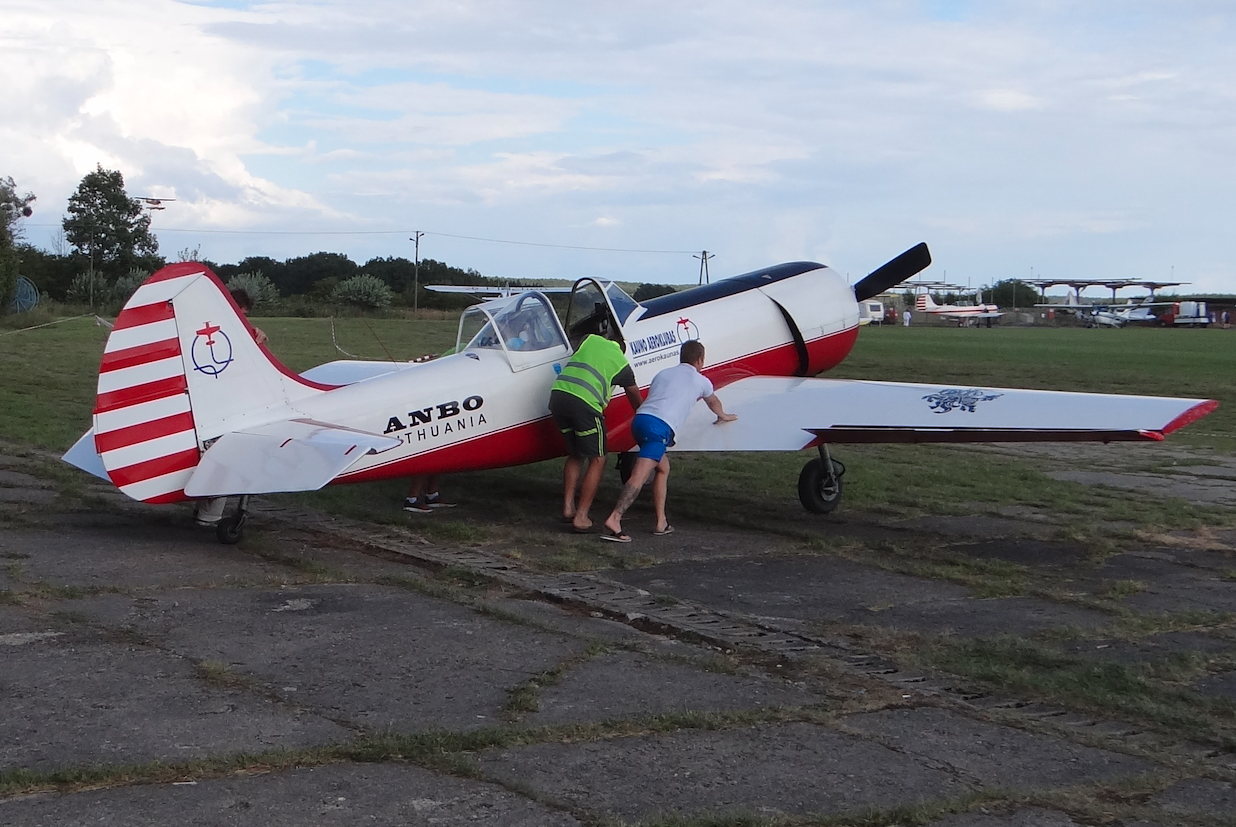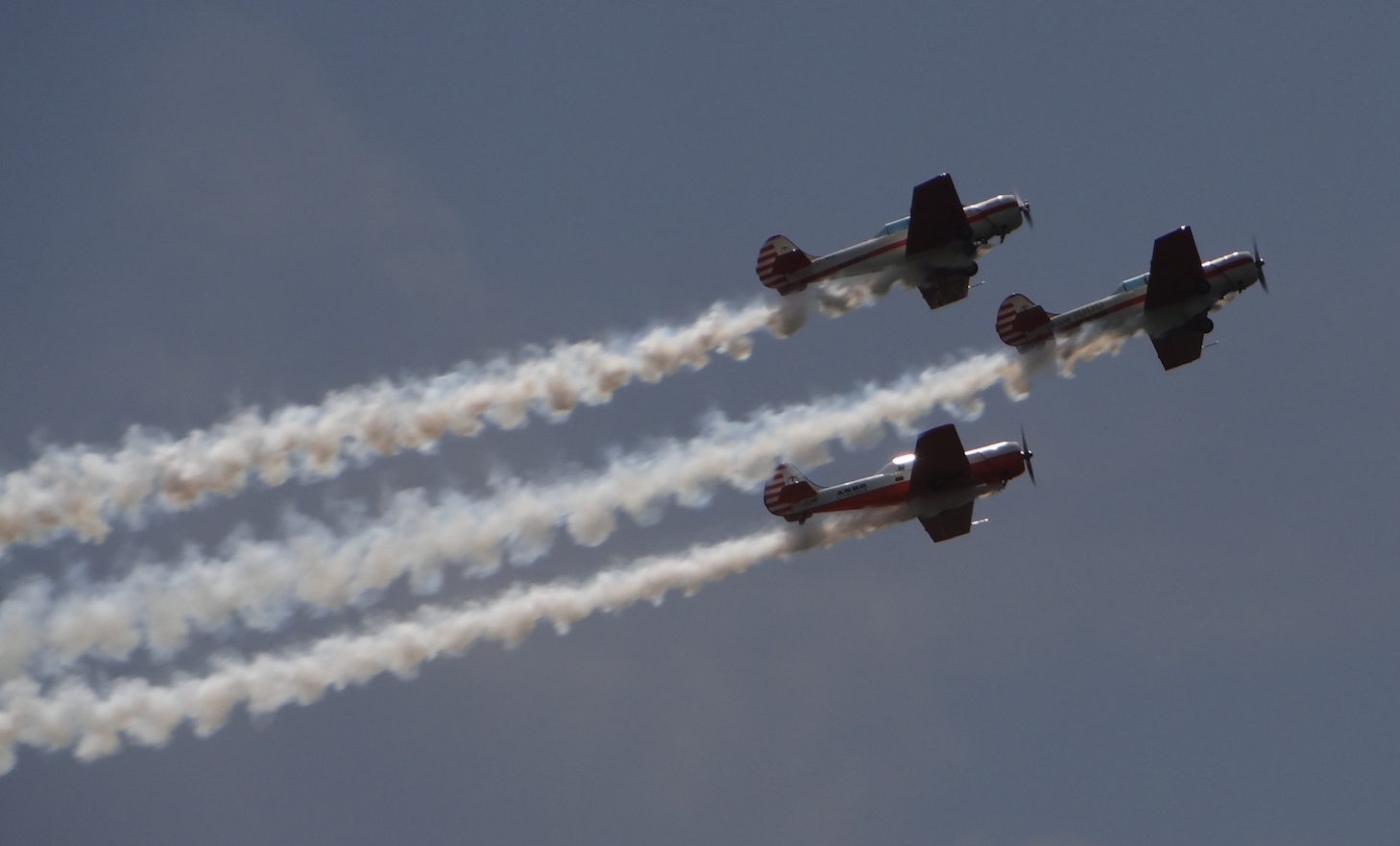History



Jak-18 A.
In CCCP, the first aircraft that was suitable for aerobatics was the Jakowlew Jak-18 in version A (Acrobatic). The Jak-18 A was built in 1957, when the Yak-18 airframe was equipped with the AI-14 R engine. The Ivchenko AI-14 R engine is a piston, radial, 9-cylinder, air-cooled engine with a power of 162 kW (220 KM). The engine has a capacity of 10.16 liters. The compression ratio is 5.9: 1. The motor diameter is 0.985 m. The motor length is 0.956 m.
Jak-50.
In 1971, the Jak-18 T was developed, which was powered by a Viennese M-14 engine with a capacity of 221 kW (300 hp). On the basis of this aircraft, a typical aerobatic aircraft was developed, designated Yak-50. The requirements for the plane were developed by the DOSAAF organization. The Jak-50 plane made its first flight in 1974. After some time, the plane received the M-14 P engine, with a capacity of 265 kW (360 HP). The Yak-50 aircraft was the work of young designers headed by Alexander Aleksandrowicz Yakovlev, son of the famous designer Alexander Sergeyevich Yakovlev, who supervised the entire program. Aleksandr Sergeyevich Yakovlev (1906-1989) had three children: sons Alexander and Vladimir, and a daughter, Elena.
When designing the Jak-50, attention was paid to the airframe's strength, stability and controllability. Manufacturing and production methods were also analyzed. The main method of connecting airframe elements is riveting, but gluing and welding have also been used. The strong point of the aircraft was its Wiedieniejew M-14 P engine, with the power of 265 kW (360 HP).
The Jak-50 aircraft turned out to be a successful aerobatic aircraft. The airframe withstands overloads from + 7g to –5g and can "barrels" at speeds of up to 180 degrees per second. In 1976, the Jak-50 plane outclassed rivals from socialist countries at a competition in Kiev. The pilots (women and men) from CCCP won 7 medals. In August 1982, the Russian W. Smolin won the gold medal at the 11th World Championships in Austria. The Russians also won gold medals as a team (women and men).
Jak-52.
Another aircraft, designated the Jak-52, was a development of the Jak-50. The constructors' work advanced very quickly and the prototype was ready within 12 months. The Jak-52 prototype was flown in 1976. Serial production was started in Romania at the Aerostar plants.
Unlike the Jak-50, the new Jak-52 has a tandem double cabin. To improve visibility from the cabin, the plane received a three-support landing gear with a front wheel. Despite giving up the aerobatic features of the aircraft, the Jak-52 performs complete acrobatics like its predecessor.
In 2012, 9 Jak-52 aircraft were entered into the register of Polish aircraft. In 2013, the register included 13 aircraft with registration marks SP-YDD, SP-YDE, SP-YDG, SP-YDH, SP-YDN, SP-YDO, SP-YDT, SP-YDU, SP-YFC , SP-YFG, SP-YLB, SP-YNH, SP-YUH. In 2015, another 8 aircraft were registered, so by the end of this year, there were already 34 Jak-52 aircraft in Poland. In January 2019, there were 51 Jak-52 aircraft in the register. The planes are mainly Romanian production.
Jak-55.
In 1982, a new Jak-55 aerobatic plane was tested. In the same year (1982), the prototype Jak-55 took part in the World Cup in Austria, but was not successful at that time. The aircraft has a changed layout from a low wing to a medium wing. The single-seater cabin is covered with a drip fairing that can be moved to the rear. The fuselage has been lengthened. The chassis is three-support, fixed, with a tail wheel. The main landing gear is single-leg with spring suspension. The main landing gear wheels were made smaller and fitted with fairings. The construction of the Jak-55 aircraft withstands overloads from + 9g to -9g.
The Jak-55 is a single-seat aerobatic aircraft, built in a classic configuration, all metal. The aircraft structure withstands overloads from + 9g to -9g. The single-spar sash has a symmetrical profile with a thickness of 18%. The wings are equipped with one-piece flaps, with breach flaps that take up 75% of the trailing edge. The wing has no lift. The single-seater cabin is covered with a drip fairing that can be moved to the rear. Additionally, in the lower part of the cockpit there are small windows that improve the pilot's visibility of the ground.
The Jak-55 uses smaller wheels with dimensions of 350 mm x 135 mm. The main chassis is 2.00 m wide. Access to the engine is very easy. The engine cover is folded to the sides in the form of two halves.
Construction
The Jak-50 is an aerobatic, single-seat, classic, all-metal aircraft. The aircraft structure can withstand overloads from + 9g to -6g. The Jak-50 and Jak-55 aerobatic planes have one main fuel tank with a capacity of 55 liters or 50 liters.
The Jak-52 is a multi-role, two-seater, classic, all-metal plane.
Trapezoidal wings are mounted to the fuselage at the bottom (low wing). The Yak-55 is a medium wing aircraft. Single-girder construction with working roofing. The duralumin sheet is covered with sheets of various thickness. A Clark UH profile was used. The profile thickness at the fuselage is 14.5% and 9% at the end of the wing. Equipped with take-off and landing flaps and ailerons. There are fuel tanks in the nose part, an oil cooler and a battery in the middle part. Ailerons are slotted with axial compensation and bulk equipment. An oil cooler, battery and main landing gear mounting nodes are located in the area of the center wing.
The fuselage of the aircraft is semi-shell, consists of 20 duralumin frames and 14 stringers. The three frames are reinforced and the wings are attached to them. The thickness of the duralumin sheet cover is 0.6 mm, 1.0 mm and 1.5 mm. Covered cabins.
The tail is classic, divided into rudders and fins. The horizontal and vertical legs are single-spar construction.
Chassis.
The chassis is three-support. Oil-gas shock absorbers were used. Pneumatics adapted for use at airports with a ground surface (grass) were used. The Jak-50 has retractable main wheels and a fixed rear tail wheel. The Jak-52 has a front support and all wheels are retractable. The front landing gear is retracted back into the fuselage. The main landing gear retracts forward into the wings. The Jak-55 has a fixed main landing gear complete with a fixed tail wheel. All chassis have brakes and shock absorption. The brakes are pneumatic.
Engine.
The plane is powered by a Viennese M-14 P piston engine with a capacity of 265 kW (360 HP). The engine is a 9-cylinder star with a supercharger. The compressor is of the centrifugal type. The engine moves a two-bladed propeller that has a variable pitch. The propeller type V-53 OTA D-35, with a diameter of 2.35 m. The propeller can be equipped with a cap.
The fuel system enables full acrobatics and inverted flight. The fuel tank with a capacity of 2 x 65 liters (in the Jak-52 plane) is installed in the fuselage near the center wing. The Jak-50 and Jak-55 aircraft have one fuel tank with a capacity of 50 or 55 liters. The service tank is located in the hull by the engine with a capacity of 5.5 liters. It is this tank that ensures engine operation in inverted flight and a two-minute flight with negative overloads. An additional tank can be installed in the fuselage to increase the range of the aircraft. Then the plane has a range of up to 500 km. In front of the engine, there are movable louvers with which the engine temperature is regulated.
Data T-T Jak-55:
Span 8.20 m. Length 7.48 m. Height 2.00 m. Load-bearing area 14.3 m2. curb weight 840 kg. Maximum speed 320 km / h. Rate of climb 16 m / s.
Tally
The Jak-50, Jak-52 and Jak-55 planes in Poland are relatively popular. The most numerous are the Yak-52 aircraft, of which 51 were registered in 2019. There are fewer typical Jak-50 and Jak-55 aerobatic planes, because in Poland aerobatic planes from Czechoslovak (Czech) Zlin are more popular.
Written by Karol Placha Hetman
